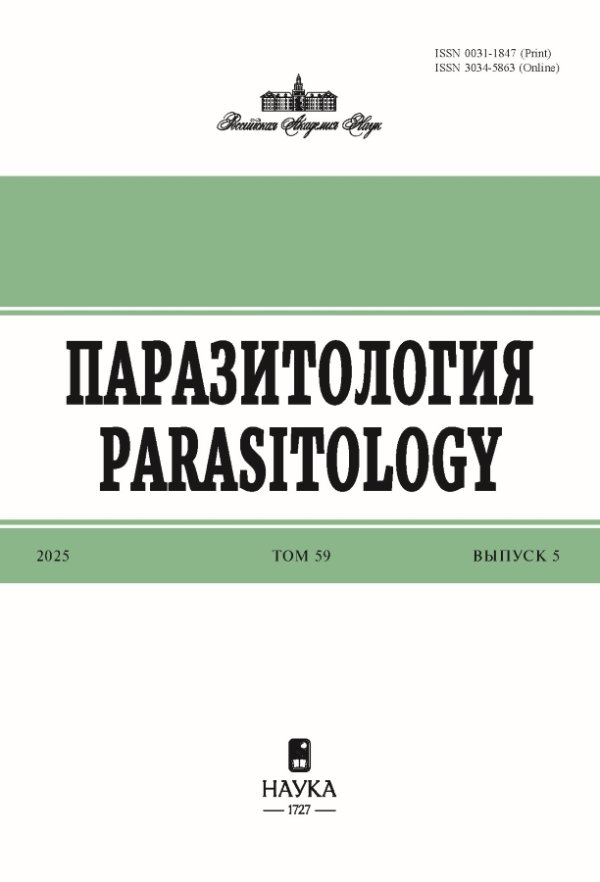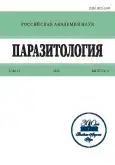The phenomenon of attachment and feeding of unfed ticks (ixodoidea) on fed and feeding specimens of the same or different species: terminological issues
- Authors: Uspensky I.V.1
-
Affiliations:
- Иерусалимский еврейский университет
- Issue: Vol 57, No 4 (2023)
- Pages: 310-318
- Section: Articles
- URL: https://journals.rcsi.science/0031-1847/article/view/142139
- DOI: https://doi.org/10.31857/S0031184723040026
- EDN: https://elibrary.ru/KHAVPQ
- ID: 142139
Cite item
Full Text
Abstract
Keywords
About the authors
I. V. Uspensky
Иерусалимский еврейский университет
Email: igorusp.acarina@gmail.com
References
- Алексеев А.Н., Чунихин С.П. 1990. Обмен вирусом клещевого энцефалита между иксодовыми клещами, совместно питающимися на животных с подпороговым уровнем вирусемии. Медицинская паразитология и паразитарные болезни 2: 48-50.
- Alekseev A.N., Chunikhin S.P. 1990. Exchange of the tick-borne encephalitis virus between ixodid ticks simultaneously feeding on the animals with the subthreshold level of viremia. Meditsinskaya parazitologiya i parazitarnye bolezni 2: 48-50. (in Russian).
- Балашов Ю.С. 1967. Кровососущие клещи (Ixodoidea) - переносчики болезней человека и животных. Л., Наука, 320 с.
- Balashov Yu.S. 1967. Bloodsucking ticks (Ixodoidea) - vectors of diseases of man and animals. Leningrad, Nauka, 320 pp. (in Russian).
- Балашов Ю.С. 1982. Паразито-хозяинные отношения членистоногих с наземными позвоночными. Л.: Наука, 316 с.
- Balashov Yu.S. 1982. Parasite-host relationships of arthropods with terrestrial vertebrates. Leningrad, Nauka, 316 pp. (in Russian).
- Балашов Ю.С. 2009. Паразитизм клещей и насекомых на наземных позвоночных. СПб.: Наука, 358 с.
- Balashov Yu.S. 2009. Acari and insect parasitism on terrestrial vertebrates. St. Petersburg, Nauka, 358 pp. (in Russian).
- Беклемишев В.Н. 1961. Термины и понятия, необходимые при количественном изучении популяций эктопаразитов и нидиколов. Зоологический журнал 40 (2): 149-158.
- Beklemishev V.N. 1961. Notions and terms used in quantitative study of populations of ectoparasites and nidicoles. Zoologicheskii Zhurnal 40 (2): 149-158. (in Russian).
- Васильева И.С., Ганушкина Л.А. 2017. Клещи, вредящие здоровью человека. Ростов н/Дону: Феникс. 157 с.
- Vasilieva I.S., Ganushkina L.A. 2017. Ticks damaging human health. Rostov n/Don, Phoenix, 157 pp. (in Russian). ISBN 978-5-222-27441-5
- Васильева И.С., Ершова А.С. 1980. Влияние плотности популяции клеща Ornithodoros papillipes (Argasidae) на яйцекладку в условиях эксперимента. Паразитология 14 (5): 392-397.
- Vasilieva I.S., Ershova A.S. 1980. The influence of Ornithodoros papillipes population density (Argasidae) on oviposition under experimental conditions. Parazitologiya 14 (5): 392- 397. (in Russian).
- Зотов С. 2021. Культурная история летучей мыши. Нож. [Электронный ресурс]. Режим доступа: https://knife.media/bat
- Zotov S. 2021. Cultural history of the bat. Nozh. Режим доступа: https://knife.media/bat/ (in Russian).
- Клюшкина Е.А. 1956. Редкий случай каннибализма у клещей семейства Ixodidae. Зоологический журнал 35 (4): 614-615.
- Klyushkina E.A. 1956. A rare case of cannibalism in ticks of Ixodidae family. Zoologicheskii Zhurnal 35 (4): 614-615. (in Russian)*.
- Кузякин А.П., Второв П.П. 1971. Подотряд Кожановые, или Летучие мыши (Vespertilioidei). В кн.: Наумов Н.П. (Ред.). Жизнь животных. Т. 6. Млекопитающие, или звери. М., Просвещение, 111-120.
- Kuzyakin A.P., Vtorov P.P. 1971. The subtype Vespertilioidei. In: Naumov N.P. (Editor). Zhizn' zhivotnykh. V. 6. Mlekopitayushchiye ili Zveri. Moscow, Prosveshcheniye: 111-120. (in Russian).
- Ланге А.Б. 1969. Подтип Хелицеровые (Chelicerata). В кн.: Зенкевич Л.А. (Ред.). Жизнь животных. Т. 3. Беспозвоночные. М., Просвещение: 10-134.
- Lange A.B. 1969. The subtype Chelicerata. In: Zenkevich L.A. (Editor). Zhizn' Zhivotnykh. V. 3. Bespozvonochnye. Moscow, Prosveshcheniye: 10-134. (in Russian).
- Леонович С.А. 2019. О типах паразитизма иксодовых клещей (Ixodidae). Паразитология 53 (5): 416-420.
- Leonovich S.A. 2019. Types of parasitism of the hard ticks (Ixodidae). Parazitologiya 53 (5): 416-420. (in Russian). doi: 10.1134/S0031184719050053
- Леонович С.А. 2022. Афагия самцов у иксодовых клещей подсемейства Ixodinae. Паразитология 56 (4): 267-281.
- Leonovich S.A. 2022. Male aphagia in ixodid ticks of the subfamily Ixodinae. Parazitologiya 56 (4): 267-281. (in Russian). doi: 10.31857/S0031184722040019
- Никитина Р.Е. 1959. Явление каннибализма у клещей Argas persicus (Oken, 1818). ДАН СССР 129 (3): 711-712.
- Nikitina R.E. 1959. Cannibalism among Argas persicus (Oken, 1818). Doklady Akademii Nauk SSSR 129 (3): 711-712. (in Russian)*.
- Павловский Е.Н. 1929. Клещи Ornithodorus в связи с проблемой клещевого тифа вообще и в Средней Азии в частности. В кн.: Животные паразиты и некоторые паразитарные болезни человека в Таджикистане. Л., Наркомздрав СССР, 84-122.
- Pavlovsky E.N. 1929. Ticks of the genus Ornithodorus in connection with the problem of the tick-borne relapsing fever in general and in Central Asia in particular. In: Zhivotnye parasity i nekotorye parazitarnye bolezni cheloveka v Tadzhikistane. Leningrad, Narkomzdrav SSSR, 84-122. (in Russian)*.
- Петрищева П.А. 1947. Каннибализм у клещей Ornithodorus как возможный путь передачи спирохет клещевого возвратного тифа. Новости медицины 5: 24-26.
- Petrishcheva P.A. 1947. Cannibalism in Ornithodorus ticks as a possible transmission route for spirochetes of tick-borne relapsing fever. Novosti Meditsiny 5: 24-26. (in Russian)*.
- Поспелова-Штром М.В. 1953. Клещи-орнитодорины и их эпидемиологическое значение. М.: Медгиз. 236 с.
- Pospelova-Shtrom M.V. 1953. Ornithodorinae ticks and their epidemiological importance. Moscow, Medgiz, 236 pp. (in Russian)*.
- Поспелова-Штром М.В. 1974. Аргасовые клещи. В кн.: Дербенева-Ухова В.П. (Ред.), Руководство по медицинской энтомологии. М., Медицина: 270-283.
- Pospelova-Shtrom M.V. 1974. Argasid ticks. In: Rukovodstvo po meditsinskoi entomologii. Moscow, Medgiz: 270-283. (in Russian).
- Узаков У.Я. 1961. Омовампиризм у иксодовых клещей. Зоологический журнал 40 (4): 608-609.
- Uzakov U.Ya. 1961. Intraspecific parasitism (omovampirism) in ixodid ticks. Zoologicheskii Zhurnal 40 (4): 608-609. (in Russian)*.
- Филиппова Н.А. 1966. Аргасовые клещи (Argasidae). Фауна СССР, Паукообразные, Т. 4. Вып. 3. М.-Л., Наука, 256 c.
- Filippova N.A. 1966. Argasid Ticks (Argasidae). Fauna SSSR, Paukoobraznye, V. 4, Issue 3. Moscow-Leningrad, Nauka, 256 pp. (in Russian).
- Чеботаревич Н.Д. 1950. К изучению эпидемического (клещевого) рекурренса и клещей Ornithodoros в Ставропольском крае. Медицинская паразитология и паразитарные болезни 19 (6): 519-521.
- Chebotarevich N.D. 1950. The study of epidemic (tick-borne) recurrence and Ornithodoros ticks in the Stavropol' Region. Meditsinskaya Parazitologiya i Parazitarnye Bolezni 19 (6): 519-521. (in Russian).
- Alekseev A.N. 1991. Ecology of tick-borne encephalitis virus: part of Ixodidae ticks males in its circulation. Ecological Parasitology 1: 51-62.
- Alekseev A.N., Dubinina H.V. 1996. Venereal and cannibalistic ways of Borrelia burgdorferi sensu lato exchange between males and females of Ixodes persulcatus (Ixodidae, Acarina). Roczniki Akademii Medycznei w Bialymstoku 41: 103-110.
- Anastos G. 1948. Accidental parasitism of a tick by a tick. Psyche 55: 36-37.
- Arthur D.R. 1962. Ticks and Disease. Oxford, New York, Pergamon Press, 445 pp.
- Barber C.A. 1895. The tick pest in the tropics. Nature 52 (1339): 197-200.
- Barber P. 1988. Vampires. Burial and Death: Folklore and Reality. N.Y., Yale Univ. Press, 244 pp.
- Bhat V.K.M. 1969. Parasitism of males of Ornithodoros (Pavlovskyella) tholozani var. crossi (Laboulene & Megnin, 1882) Argasidae: Ixodoidea, on fed nymphs and females of the same species. Journal of Bombay Natural History Society 66: 401-403.
- Booth E., Alyokhin A., Pinatti S. 2017. Adult cannibalism in an oligophagous herbivore, the Colorado potato beetle. Insect Science 24: 295-302. doi: 10.1111/1744-7917.12286
- Buczek A., Bartosik K., Buczek A.M., Buczek W., Stanko M. 2019. Conspecific hyperparasitism in the Hyalomma excavatum tick and considerations on the biological and epidemiological implications of this phenomenon. Ann. Agricultural Environmental Medicine 26: 548-554. doi: 10.26444/aaem/110128
- Davis G.E. 1941. Ornithodoros parkeri Cooley: Observations on the biology of this tick. Journal of Parasitology 27: 425-433.
- Durden L.A., Gerlach R.F., Beckmen K.B., Greiman S.E. 2018. Hyperparasitism and non-nidicolous mating by male Ixodes angustus ticks (Acari: Ixodidae). Journal of Medical Entomology 55: 766-768. doi: 10.1093/jme/tiv012
- Fenton B.M. 1992. The vampire bat. In: Bats. Oxford & N.Y., Facts on File Inc.: 149-155.
- Francis E. 1938. Longevity of the tick Ornithodoros turicata and of Spirochaeta recurrentis within this tick. Public Health Report 53: 2220-2241.
- Godfray H.C.J. 1994. Parasitoids: Behavioral and Evolutionary Ecology. Princeton, N.J., Princeton University Press, 473 pp.
- Gray J.S., Estrada-Peña A., Vial L. 2014. Ecology of nidicolous ticks. In: Sonenshine D.E., Roe R.M. (Editors). Biology of Ticks, V. 2. New York, Oxford Univ. Press, 39-60.
- Helmy N., Khalil G.M., Hoogstraal H. 1983. Hyperparasitism in Ornithodoros erraticus. Journal of Parasitology 69: 229-233.
- Hooker W.A., Bishopp F.C., Wood H.P. 1912. The life history and bionomics of some North American ticks. Washington, Govern. Printing Office, 239 pp.
- Hu R., Hyland K.R., Oliver J.H., Jr. 1998. A review on the use of Ixodiphagus wasps (Hymenoptera: Encyrtidae) as natural enemies for the control of ticks (Acari: Ixodidae). Systematic and Applied Acarology 3: 19-28. https://doi.org/10.11158/saa.3.1.3
- Iyengar E.V. 2008. Kleptoparasitic interactions throughout the animal kingdom and re-evaluation, based on participant mobility, of the conditions promoting the evolution of kleptoparasitism. Biological Journal of the Linnean Society 93: 745-762. https://doi.org/10.1111j.1095-8312.2008
- Labruna M.B., Ahid S.M.M., Soares H.S., Suassuna A.C.D. 2007. Hyperparasitism in Amblyomma rotundatum (Acari: Ixodidae). Journal of Parasitology 93: 1531-1532. doi: 10.1645/GE-1277.1
- Lhomme P., Hines H.M. 2019. Ecology and evolution of cuckoo bumble bees. Annals of the Entomological Society of America 112: 122-140. https://doi.org/10.1093/aesa/say031
- Llanos-Soto S., Muñoz-Leal S., González-Acuña D. 2019. Hyperparasitism in the seabird tick Ornithodoros amblus (Acari: Argasidae). Systematic and Applied Acarology 24: 525-528. https://doi.org/10.11158/saa.24.3.16
- Moorhouse D.E. 1966. Observations on copulation in Ixodes holocyclus Neumann and the feeding of the male. Journal of Medical Entomology 3: 168-171.
- Moorhouse D.E., Heath A.C.G. 1975. Parasitism of female ticks by males of the genus Ixodes. Journal of Medical Entomology 12: 571-572.
- Norval R.A.I. 1974. Copulation and feeding in males of Ixodes pilosus Koch, 1844 (Acarina: Ixodidae). Journal of the Entomological Society of Southern Africa 37: 129-133.
- Ntiamoa-Baidu Y. 1986. Parasitism of female Ixodes (Afrixodes) moreli (Acari: Ixodidae) by males. Journal of Medical Entomology 23: 484-488.
- Phillips J.S., Adeyeye O., Bruni D. 1995. Respiratory metabolism of the soft tick, Ornithodoros turicata (Dugès). Experimental and Applied Acarology 19: 103-115. doi: 10.1007/BF00052550
- Plowright W. 1981. African swine fever. In: Davis I.W., Karstad L.H., Trainer D.O. (Editors). Infectious Diseases of Wild Mammals, 2nd Ed. Ames, Iowa, Iowa University Press: 178-190.
- Rodrigues D.S., Labruna M.B., Ferreira L.L., Leite R.C. 2023. First description of conspecific hyperparasitism in Amblyomma sculptum. Ticks and Tick-Borne Diseases 14: 102092. https://doi.org/10.1016/j.ttbdis.2022.102092
- Santana A.F.K., Roselino A.C., Cappelari F.A., Zucoloto F.S. 2012. Cannibalism in insects. In: Panizzi A.R., Parra J.R.P. (Eds), Insect Bioecology and Nutrition for Integrated Pest Management. Boca Raton, CRC Press: 177-194.
- Schausberger P. 2003. Cannibalism among phytoseiid mites: A review. Experimental and Applied Acarology 29: 173-191. doi: 10.1023/a:1025839206394
- Schnytzer Y., Giman Y., Karplus I., Achituv Y. 2017. Boxer crabs induce asexual reproduction of their associated sea anemones by splitting and intraspecific theft. PeerJ 5: e2954. doi: 10.7717peerj.2954
- Sergent A. 1930. Presentation d'une nymphe de tique parasitant une autre nymphe de la même espèce. Bulletin de la Société d'histoire naturelle de l'Afrique du nord 21: 195-196.
- Sullivan D.J. 1987. Insect hyperparasitism. Annual Review of Entomology 32: 49-70.
- Theodor O. 1932. Über Ornithodorus coniceps Canestrini in Palästina. Zeitschrift für Parasitenkunde 5: 69-79.
- Uspensky I. 1996. Tick-borne encephalitis prevention through vector control in Russia: An historical review. Review of Medical and Veterinary Entomology 84: 679-689.
- Uspensky I. 2008. Argasid (soft) ticks (Acari: Ixodida: Argasidae). In: Capinera J.L. (Editor). Encyclopedia of Entomology. 2nd Edition. V. 1. Dordrecht, Springer Science: 283-288.
- Uspensky I., Braun S. 2020. Cannibalism in mosquito larvae during microbial larvicide potency tests. Folia Parasitologica 67: 005. doi: 10.14411/fr.2020.005
- Van der Wal S., Haug J.T. 2019. Letter to the editor referencing "The apparent kleptoparasitism in fish-parasitic gnathiid isopods". Parasitology Research 118: 1679-1682. doi: 10.1007/s00436-019-06281-2
- Votava C.L., Rabalais F.C., Ashley D.C. 1974. Transmission of Dipetalonema viteae by hyperparasitism in Ornithodorus tartakovskyi. Journal of Parasitology 60: 479.
- Wilder S.M., Rypstra A.L. 2008. Sexual size dimorphism predicts the frequency of sexual cannibalism within and among species of spiders. American Naturalist 172: 431-440. doi: 10.1086/589518
- Williamson B.N., Schwan T.G. 2018. Conspecific hyperparasitism: an alternative route for Borrelia hermsii transmission by the tick Ornithodoros hermsi. Ticks and Tick-Borne Diseases 9: 334-339. doi: 10.1016/j.ttbdis.2017.11.00
Supplementary files










